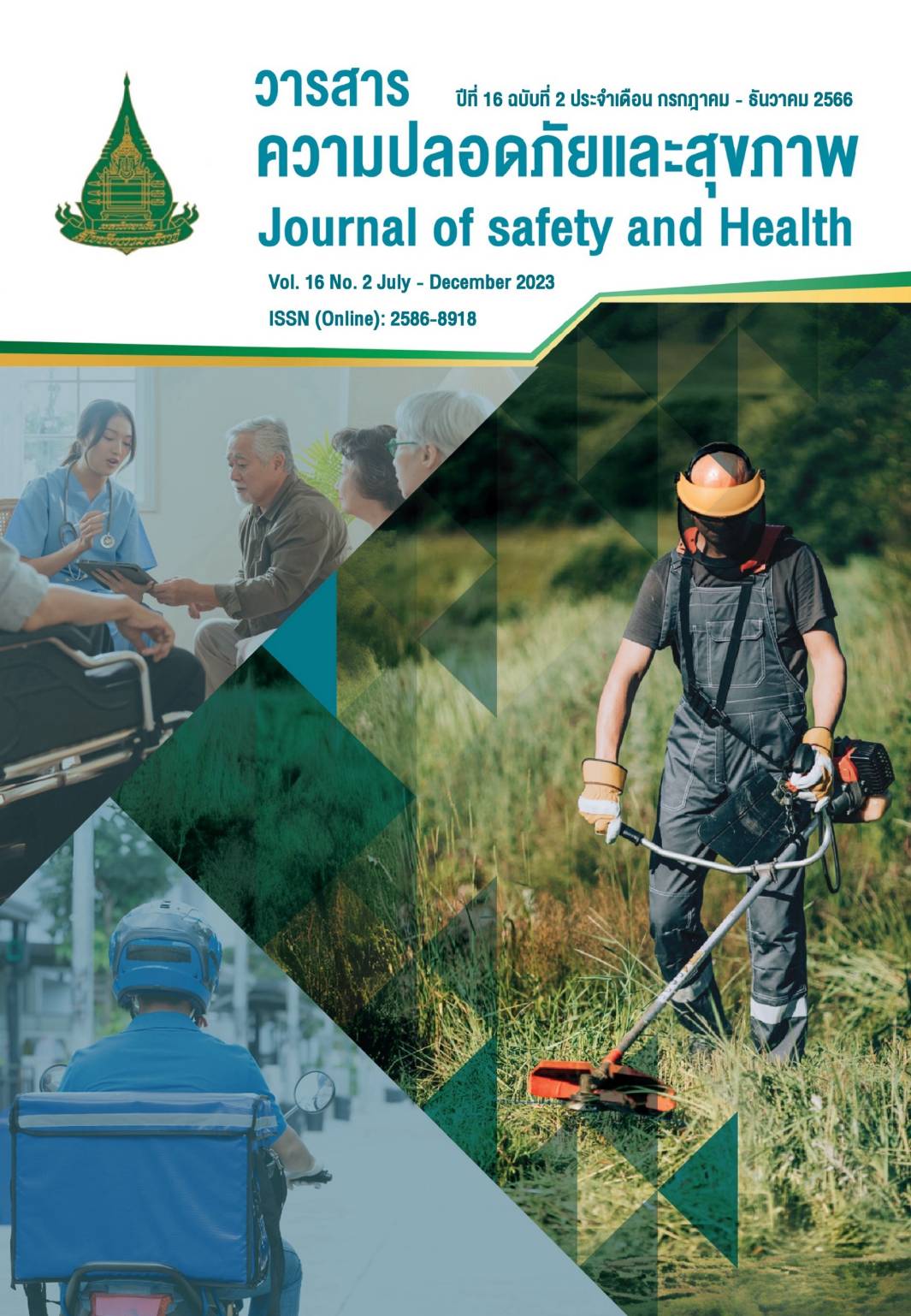The phenomenon of accidents arising from risky behavior in motorcycle riding among individuals under 15 years old: A qualitative study.
Main Article Content
Abstract
This research aimed to elucidate the conditions of risky behavior and the causes of motorcycle use among drivers under 15 years of age. Data were collected through in-depth interviews with four specific groups selected using a targeted approach: 1) Individuals under 15 years of age who had experienced motorcycle accidents; 2) Family members, guardians, teachers, or individuals related to those who had been in motorcycle accidents under 15 years of age; 3) Medical personnel involved in treating those who had experienced motorcycle accidents under 15 years of age; and 4) Individuals playing a role in road safety.
The research identified four levels of conditions related to the behaviors leading to motorcycle accidents in drivers under 15 years of age: Microsystem, consisting of three aspects: 1) Young drivers with immature judgment, lacking driving skills and displaying recklessness; 2) Peer grouping for racing and showing off unique driving styles; and 3) Families not having time to supervise their children, allowing them to drive at an inappropriate age. The microsystem is the relationship between home and school, where schools do not support but also do not forbid students from riding motorcycles due to the perceived necessity of each family regarding inconvenient travel. Exosystem, consisting of five aspects: 1) Unfavorable environmental context; 2) Middle-class economic status often requiring children to fend for themselves; 3) Lack of public transport services; 4) Motorcycles being a convenient and economical mode of transportation; and 5) Affordable motorcycle leasing options. Macro system includes two aspects: 1) A cultural norm that values modifying motorcycles for increased power and the attraction of unique driving styles; and 2) Thai cultural attitudes towards lax adherence to rules and regulations.
In conclusion, these identified conditions can be used to develop strategies to prevent the dangers arising from the driving behaviors of motorcycle drivers under 15 years of age.
Article Details

This work is licensed under a Creative Commons Attribution-NonCommercial-NoDerivatives 4.0 International License.
Journal of Safety and Health is licensed under a Creative Commons Attribution-NonCommercial-NoDerivatives 4.0 International (CC BY-NC-ND 4.0) licence, unless otherwise stated.
References
กัณวีร์ กนิษฐ์พงศ์. (2558). รายงานฉบับสมบูรณ์โครงการศึกษาแนวทางงานวิจัยด้านความปลอดภัยของรถจักรยานยนต์. ภาควิชาวิศวกรรมขนส่ง คณะวิศวกรรมศาสตร์ สถาบันเทคโนโลยีแห่งเอเชีย.
กาญจน์กรอง สุอังคะ. (2559). การศึกษาพฤติกรรมการขับขี่ของวัยรุ่นที่มีผลต่อความเสี่ยงในการเกิด อุบัติเหตุจากการใช้รถจักรยานยนต์. มหาวิทยาลัยเทคโนโลยีสุรนารี.
กุลธิดา ท่าทราย, พิรัชฎา มุสิกะพงศ์ และฤทธิรงค์ พันธ์ดี. (2564). ปัจจัยที่มีผลต่อพฤติกรรมเสี่ยงในการเกิดอุบัติเหตุจาก การขับขี่รถจักรยานยนต์ของนักเรียนชั้นมัธยมศึกษาตอนปลาย. วารสารความปลอดภัยและสุขภาพ, 14(1), 50-68.
ชนัญญา ประสาทไทย. (2561). รถจักรยานยนต์:ปฏิบัติการบนท้องถนน. วารสารธรรมศาสตร์, 37(1), 96-109.
ณัฐจิต อ้นเมฆ, จินดา คงเจริญ, อัญมณี ตนคลัง และอาริสา เอ็มบุตร. (2563). โมเดลความสัมพันธ์เชิงสาเหตุของปัจจัยด้านจิตวิทยากับพฤติกรรมขับขี่ไม่ปลอดภัยในจังหวัดภูเก็ต. วารสารสาธารณสุขมหาวิทยาลัยบูรพา, 15(2), 13-24.
ดารารัตน์ ช้างด้วง. (2562). เปิดมุมมองสะท้อนความจริงของผู้เปราะบางบนถนน (VRUs). ศูนย์วิชาการเพื่อความปลอดภัยทางถนน สำนักงานกองทุนสนับสนุนการสร้างเสริมสุขภาพ.
นงคราญ ตาต๊ะคำ. (2558). ปัจจัยที่เกี่ยวข้องกับพฤติกรรมการใช้รถจักรยานยนต์ของนักเรียนมัธยมศึกษาอำเภอภูเพียง จังหวัดน่าน [วิทยานิพนธ์ปริญญามหาบัณฑิต ไม่ได้ตีพิมพ์]. มหาวิทยาลัยเชียงใหม่.
บัณฑิต ตั้งกมลศรี. (2559). ปัจจัยเชิงสาเหตุที่มีอิทธิพลต่อพฤติกรรมการขับขี่ปลอดภัยของนักเรียนชั้นมัธยมศึกษาตอนปลายในเขตภาคเหนือ: วิเคราะห์กลุ่มพหุ [วิทยานิพนธ์ปริญญามหาบัณฑิต ไม่ได้ตีพิมพ์]. มหาวิทยาลัยบูรพา.
ประทีป นรากล่ำ. (2562). รูปแบบการแก้ไขปัญหาการแข่งรถจักรยานยนต์บนท้องถนนของเด็กแว้นในเขตความรับผิดชอบของตำรวจภูธรภาค 3. วารสารสถาบันวิจัยและพัฒนา มหาวิทยาลัยราชภัฏมหาสารคาม, 6(2), 399-418.
พรรณี ปานเทวัญ. (2560). โมเดลเชิงนิเวศวิทยากับการเปลี่ยนแปลงพฤติกรรมสุขภาพ. วารสารพยาบาลทหารบก, 18(2), 7-15.
มิณฑกานต์ สร้อยแสง และกิ่งกาญจน์ จงสุขไกล. (2563). การตอบสนองด้านวัฒนธรรมความปลอดภัยทางถนนของผู้ใช้รถใช้ถนนที่เป็นกลุ่มเสี่ยงในเขตพื้นที่เสี่ยงจังหวัดปทุมธานี. วารสารมนุษย์ศาสตร์ ฉบับบัณฑิตศึกษา, 9(2), 125-140.
วัชรพงษ์ เรือนคำ และณรงค์ศักดิ์ หนูสอน. (2562). อุบัติเหตุรถจักรยานยนต์ในประเทศไทย: มุมมองทางวิทยาการระบาด. วารสาร มฉก.วิชาการ, 23(1), 146-160.
ศูนย์ข้อมูลอุบัติเหตุ. (2565, 24 กุมภาพันธ์). ข้อมูลสถิต ผู้เสียชีวิตจากอุบัติเหตุ. ศูนย์ข้อมูลอุบัติเหตุ. ThaiRSC, https://www.thairsc.com/.
ศูนย์วิชาการเพื่อความปลอดภัยทางถนน. (2564, 21 พฤษภาคม). รายงานสถานการณ์อุบัติเหตุทางถนนของประเทศไทย 2561-2564. http://www.roadsafetythai.org/.
สำนักงานปลัดกระทรวงสาธารณสุข, กองยุทธศาสตร์และแผนงาน. (2563, กันยายน). สถิติสาธารณสุข พ.ศ. 2562. ศูนย์ข้อมูลข่าวสารด้านเวชภัณฑ์ กระทรวงสาธารณสุข, https://dmsic.moph.go.th/index/detail/8297
Boramanan, N. (2012). The New Standard of Public Service in Thailand. Winyuchon.
Bronfenbrenner, U. (1974). Developmental research, public policy, and the ecology of childhood. Child Development, 45(1), 1-5.
Broom, L., & Selznick, P. (1971). Sociology (4th ed.). Harper & Row.
Buckley, L., Chapman, R. L., & Sheehan, M. (2014). Young Driver Distraction: State of the Evidence and Directions for Behavior Change Programs. Journal of Adolescent Health, 54(5, Supplement), S16-S21. https://doi.org/10.1016/j.jadohealth.2013.12.021
Harkonen, U. (2007). The Bronfenbrenner ecological systems theory of human development. In Scientific articles of V international conference: Person color nature music. World Health Organization, https://apps.who.int/ iris/handle/10665/160762.
Hyder, A. A., Waters, H., Phillips, T., & Rehwinkel, J. (2007). Exploring the economics of motorcycle helmet laws-implications for low and middle-income countries. Asia Pacific Journal of Public Health, 19(2), 16-22.
McLaren, L., & Hawe, P. (2005). Ecological perspectives in health research. Journal of Epidemiology and Community Health, 59, 6-14.
Miles, M. B., & Huberman, A. M. (1994). Qualitative Data Analysis: An Expanded Sourcebook. Sage Publications.
Pirchio, S., Passiatore, Y., Tritrini, C., & Taeschner, T. (2013). The Role of the Relationship between Parents and Educators for Child Behaviour and Wellbeing. International Journal about Parents in Education, 7(2), 145-155.
Sumit, K., Brijs, K., Ross, V., Wets, G., & Ruiter, A. C. R. (2022). A Focus Group Study to Explore Risky Ridership among Young Motorcyclists in Manipal, India. Safety, 8(2), 1-27. https://doi.org/10.3390/safety8020040
World Health Organization. (2018, February 6). Global Status Report on Road Safety. https://www.who.int/publications/i/item/9789241565684.
World Health Organization. (2015, February 6). Child development and motorcycle safety. https://apps.who.int/iris/handle/10665/160762.


